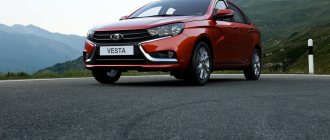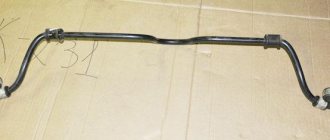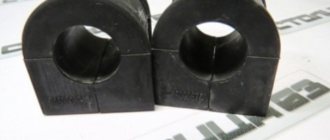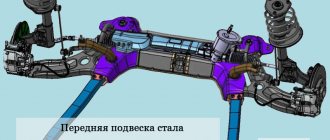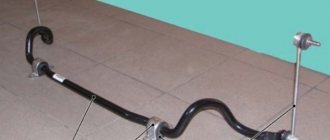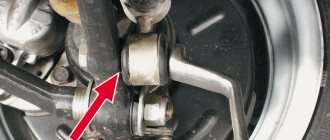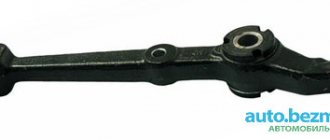The Chevrolet Niva belongs to the class of SUVs and high-clearance cars, but what does this mean? This indicates the possibility of instability on the road surface at high speeds. Indeed, performing any maneuvers in jeeps and SUVs is extremely risky and dangerous. Off-road vehicles are even more susceptible to this effect when maneuvering or turning the steering wheel sharply at speed.
It is in order to eliminate or reduce the likelihood of skidding and rollover that manufacturers of SUVs make some adjustments to the control system, or, more precisely, supplement the body mechanism with a stabilizer bar, which is what this article will talk about. Let's look at the purpose of the device and its design, and also find out what the product catalog number is.
A little about the operation of a car suspension
It is not difficult to guess that the level of safety and comfort on the road for both the driver and passengers almost directly depends on the serviceability of the suspension, as well as how well it copes with its tasks.
Each vehicle suspension component is aimed at a specific function. The levers, together with the axles, hold the wheel in the required plane, while simultaneously allowing it to rotate freely in two different planes (the moment of turning into a turn).
Shock absorbers dampen vibrations that occur during movement, thereby ensuring a smooth ride of the vehicle. At the same time, the springs are designed to ensure the rigidity of the suspension and return its components to their original state.
Main components and components of the car front suspension
This is interesting: Schematic diagram of the illumination of instruments and controls without a brightness control Chevrolet Lacetti 2004 - 2013
Anti-roll bar
But there is one more important detail in the suspension, without which no modern car can do. And this part is a stabilizer. It can be easily seen if the car is driven onto a lift or placed on a viewing hole. On the front axle, among the springs, shock absorbers and other levers, you will easily notice a curved steel rod, which is attached to the subframe with one arm and to the wheel hub with the other. The stabilizer mounts are not rigid and allow it to move along the axis in one plane.
The stabilizer appeared in the suspension design at the dawn of the automotive industry, when speeds began to reach 20 km/h and above. The introduction of this element into the suspension design made it possible to ensure that the vehicle remains stable when cornering and maneuvering.
Thus, the main task of the stabilizer during movement is to distribute the weight of the car body over all its wheels in the event of a roll. In particular, this applies to cases of fairly sharp turns or when there is a sudden change in the trajectory of movement.
The principle of operation of the anti-roll bar
On the McFerson type of suspension, which is quite common today, the stabilizer is a torsion bar that acts on torsion. This element is rigidly connected to the car body or subframe. The forces generated in the suspension are transmitted to the stabilizer through additional levers, which communicate with the suspension through hinges. This simple scheme allows you to prevent even a serious roll of the vehicle, and even more so, its rollover.
The rear axle is most often equipped with a stabilizer of this type if the vehicle has all-wheel drive. If we talk about cars with rear-wheel drive and a solid beam on the rear axle, then the role of the stabilizer is given to the reaction bar, also known as the Panhard rod.
Also, a number of Japanese off-road vehicles at one time, in addition to the Panhard rod, were additionally equipped with another stabilizer, which, in the form of a curved rod, ran along the rear axle beam and communicated with the power components of the body through small levers.
Stabilizer rubber bands
Let's start with the fact that I'm tired of some kind of extraneous sound from the front right side. Having looked at the front end, I noticed that the stabilizer rubber bands were somewhat worn out. It was decided to start with them. I’m going to the market and buying “front stabilizer bar cushions for a VAZ 2123” from BRT. article 2123-2906040R - 4 pcs. 2123-2906046R - 2 pcs. We also bought a fuel filter, the first one that caught my eye.
and the expansion tank cap, since the old one did not hold pressure at all
The cover was changed almost immediately, two days later we got to the filter and only yesterday I decided to use rubber bands... I took off the stabilizer quickly, since I removed the protection that weekend when replacing the fuel filter.
The condition of the rubber bands is, let’s say, “crappy.” We clean the stabilizer from dirt and rust, and notice some strange marks along the edges, similar to welding, and some bends are also visible in this place
It was decided to change it to a new one, but not now. Installing new rubber bands using liquid soap
Let's begin the installation... 2 hours pass, and I still can't screw the clamps to the levers... I decided to try first screwing them to the body and to the bridge, and then to the lever...
It got even worse... By the way, my new jack, given by my wife on February 23
Let's continue... We unscrew everything back... We remove the wheel... And we try to screw it to the lever not from the hole, but from the top... And an hour later, with the help of pry bars, hammers, clamps and a lot of other things that came to hand, we still attach the stabilizer clamps to the levers... Pants full of joy... We take a smoke break, drink tea and climb back into the hole to tighten the clamps... And then:
I called my sister's husband, and after 40 minutes I had (just in case) two new clamps... We put everything in place... By the way, while I was waiting for new clamps, I decided to fix the rear wiper, threw off the spare wheel, unscrewed the leash, cut off all the excess there and put it back ... I didn’t have time to try it right away, since the clamps had already arrived. I only tried it when I arrived home. The janitor began to clean)
)))))
Well, now how can this be... new stabilizer rubber bands, a new filter, a working rear wiper... and a peeling front nameplate... no big deal
We take it off and... accidentally break it(((
We take it home, wash it, glue it with super glue and soda... And cover it with black vinyl...
Source
Stabilizer bushings. Signs of malfunction. Consequences.
For the best damping of vibration and force impacts on the car body, the vast majority of suspension elements are connected by means of elastic elements. The same applies to the stabilizer. To secure it, special bushings (rubber bands, cushions) made of durable rubber or polyurethane are used. Over time, as the vehicle is used, these bushings may begin to deteriorate and noticeably lose their elasticity. The result of this is unsatisfactory operation of the stabilizer =. More serious defects may begin to appear, which will only grow faster over time.
Diagram of the stabilizer device and its fastening elements
The first symptom indicating replacement of the bushings will be a slight knocking sound from the suspension. A similar knock can be observed with “tired” shock absorbers. Only in the case of bushings it will be heard not only on potholes and potholes, but also when entering relatively sharp turns. At the same time, the car often feels excessively rolly and sluggish. The knocking sound that appears will be a consequence of play that has arisen in the connecting nodes of the stabilizer arms due to worn bushings.
If measures are not taken in time, the knocking will only intensify in the future and will begin to accompany the operation of the suspension everywhere due to increasing deformation and destruction of the bushings. Body roll and excessive play in the steering wheel may occur. The car may “yaw” not only when turning, but also when braking or changing lanes. Most car manufacturers recommend changing stabilizer bushings every 30–40 thousand mileage. However, in our conditions it is better to focus on bushing wear. Therefore, a sudden knocking sound and slight rattling in corners will be clear signs of an impending component replacement.
As a popular method of checking the bushings for serviceability, it is proposed to drive the speed bump diagonally in 2nd gear. A dull knock appeared in the area of the pedals - most likely due to the hub bushings. You can also just crawl under the car and inspect everything yourself. A worn bushing will be pleased with the presence of cracks and abrasions characteristic of worn and cracked rubber. Auto mechanics sometimes also call these cracks “daisies.”
Stabilizer bushing and bracket for its fastening
Also, the rubber of the bushings can simply harden and lose the necessary elasticity. If you can’t get a good look at the stabilizer bushings, just swing your hand strongly up and down and to the sides on the stabilizer itself. If you feel play, creaks and knocks in the lower part of the suspension, it means that the bushings have become unusable.
But for the best results, it is, of course, better to drive onto an overpass, an inspection hole, or use a lift. The only tools you will need are a crowbar or a mounting spade, which you simply need to rest against the bottom of the car and slightly “shake” the stabilizer where it connects to the body. If you feel noticeable play or loss of elasticity, then it’s time to think about replacing the bushings.
Modernization of the front stabilizer. Stub bushings from Shnivy to Niva.
The fascinating journey into the world of endless field repair continues. Every day there is something new, there are days when several problems appear in a day. There is still a glimmer of hope in my soul that everything is breaking down because the Car has been standing on the street for almost 2 years and has not been used. Moreover, the problems that had already appeared came out quickly, without long-term progression and preliminary symptoms. The steering rod began to knock, the wear was almost critical. Before this, there were no backlashes, no pulls of the car, nothing. It just rattled loudly right away. The clutch slave cylinder leaked within 24 hours. It was dripping in the evening, and the next morning it was running like a stream. Yesterday the bridge was dry, today it’s just pouring from the axle shaft seal - the whole disc is covered in oil. Same with the stub. The day before yesterday I was driving, everything was smooth, suddenly it started rattling from below. I got to work and dove: the left bushing flew out from under the bracket and was hanging on the tip of the stub. I bought original inner bushings and outer ones too. I twirled it in my hands... Well, the method of fixing them does not inspire confidence; the tendril only holds it from lateral movement. I bought bushings 2123. I’ll figure it out locally.
Yesterday I took off the stub and figured out that the internal diameter of the Shniv ones is 1-2 mm larger (I haven’t studied the hardware, more accurately, you can look at the diameter of the shniv stub in the catalogue) and the external size, on the contrary, is 4-5 mm smaller than the original ones.
I put thick-walled heat shrink on the stub.
I placed stainless steel inserts in the brackets.
Well, to hell with it. Normal heroes always take a detour
